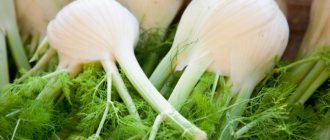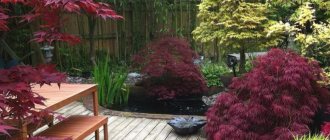Magnolia in the Samara region. July 2021 As it turns out, blindly following care instructions may well lead not to prosperity, but rather to the death of the magnolia. And now I understand perfectly well that if a heat-loving plant is to grow in the middle zone, then the “laws of the south” for cultivation may not apply here. Therefore, it is very useful, I would even say vitally important, in addition to general information, to collect practical reviews or reports on growing a plant in the middle zone, that is, in conditions as similar as possible to yours. Obviously, all of the above applies not only to magnolias, but also to other exotic plants, some of which are also capable of growing in more severe conditions.
After the rain
I wrote about the successful cultivation of two varieties of magnolias in open ground at my dacha in the Samara region in the articles Magnolia where it does not grow, but it is worth a try and Beauty Magnolia - the melody of the soul. Second year of flowering. In them you can learn about some interesting features of these wonderful plants and see beautiful photos (also in the comments) of blooming magnolias.
Now, after several years of care, it will be very useful to dwell in more detail on the main “pitfalls” in order to put together particularly important points in caring for magnolias in the middle zone, which were most clearly identified for me precisely from my own experience. Some of them can help not only grow, but also preserve this beautiful plant in weather conditions that have been completely unpredictable in recent years. And as a result - to see its magical bloom.
Magnolia
Selection of seedlings
In open ground it is worth growing varieties with the highest winter hardiness . On my site at the moment the following varieties have proven to be able to winter in open ground with a little shelter for the winter (and even without it - older ones):
- Magnolia Siebold,
- Magnolia Loebner (Leonard Messel),
- Magnolia Kobus,
- Magnolia star Royal Star,
- Magnolia hybrid George Henry Kern.
All of them overwinter well in the open ground with a small cover of spruce branches in the form of a house strapping, and without much damage they withstood temperatures dropping below 30 degrees or more in winter without much damage. Magnolia Kobus after the second winter. Spring 2021 Magnolia George Henry Kern in the spring Once again, looking at the mesmerizing photos of blooming magnolias, I caught myself thinking that no matter what magnolia you look at, they are all magnificent! And my hands began to tremble again... As a result, after much thought, I chose the following varieties for planting next year:
- Wilson's magnolia (white flowers),
- magnolia hybrid Butterflies (yellow flowers),
- magnolia hybrid Yellow lantern (yellow flowers),
- magnolia hybrid Cameo (pink flowers).
Time will tell whether my expectations from these varieties will be met. The same time has already shown that magnolias such as Sulanja and Liliaceae f. Nigra were unable to survive the winter under similar conditions. Thus, the difference in frost resistance of only 5 degrees very significantly narrows the range of varieties that should be chosen for planting in the middle zone. Therefore, for open ground when planting in our region, frost resistance of the variety up to minus 25 degrees Celsius will not be enough .
In addition, severe winters with little snow have not yet been canceled. Magnolia Star after late spring frosts
A seedling for planting in open ground must have a closed root system (CRS). Magnolia reacts extremely negatively to transplantation with an open root system (ERS) due to the fragility of the delicate roots and very slow adaptation to the new location. Even a well-developed plant may soon die after being transplanted to a new location. That is why you need to plant magnolia immediately in a permanent place .
Ads by
Where is the best place to plant magnolia?
If you want to admire an adult magnolia for many years, you need to take a very responsible approach to choosing a place to plant seedlings. It should be remembered that the tree can reach quite large sizes, so you should not plant seedlings next to tall garden crops. The graceful tree is especially annoyed by fruit trees hanging over the crown of the magnolia. The ripening heavy fruits fall from the branches and injure the crown of the magnolia.
When planting seedlings, the following conditions should be taken into account:
- Lighting - all magnolias, except M. Loebner, Kobus and star, for which direct sunlight can cause a lot of trouble, must be grown in free areas with bright lighting.
- Protection from blowing - a young tree should be planted in a windless area; it is very important that cold northern winds do not blow across the crown. Garden buildings, hedges, fences and fences can serve as a protective screen from drafts.
- Substrate - for planting magnolias, you must choose dry areas with light, fertile soil that has a neutral or slightly acidic reaction. You should definitely add humus to the soil - magnolia requires a lot of nutrients.
Important! It is not recommended to grow magnolias in areas with high salinity and calcareous soils.
The most balanced ratio when preparing soil for magnolias:
- Garden (deciduous) soil – 1 tsp.
- Peat – 2 hours.
- Coarse sand – 0.5 tsp.
Place and time for landing
- Time has shown that magnolia does well in places most protected from the wind . There it develops well and blooms.
- Open sunny areas, which are favorable for the plant in its homeland, turned out to be undesirable when planted in the middle zone. In dry and hot summers, magnolia (young plants) in full sun for a week can completely lose their foliage (which I observed twice) even with mulching. Moreover, increased watering in this case can only aggravate the situation: then the plant will lose almost all of its mass, leaving one or two lower branches, or even dry out completely.
- Magnolia at a young age needs partial shade from the sun for 1/3-1/2 daylight hours. It needs to be planted either on level ground or on a very small hill. Magnolias cannot be planted in a completely shaded area; there the plants will develop too slowly and poorly (annual growth can be only 5-7 cm), and the bark will not be prepared for the winter period.
- As it turned out, the soil for planting can be either more loose and breathable (composite), or completely left unchanged. In the latter case, watering is carried out in approximately half the volume and exclusively in the late evening .
- The time for planting young seedlings is spring . When planting in summer or autumn, the bark of annual branches most likely will not ripen and in winter the plant may die or completely shed its weakest branches. This is disastrous for young seedlings.
- Mature trees growing nearby can oppress magnolias and significantly slow down their growth.
Young magnolias in an open area need to be partially shaded
Care and preparation for winter
Magnolia is a very rare plant in central Russia and many will tell you that it is impossible to grow it, and if it does, it will cause a lot of trouble. - Don't believe it!
If you have chosen the right place for planting the plant and planted it in the “correct” soil, then the first flowers will appear on it very quickly.
Magnolia should not be transplanted from one place to another.
Loosening the soil
not deep, it is not recommended to cultivate the soil near the trunk of a tree or shrub with any garden tools or implements - the surface root system can be damaged.
Watering
If the summer turns out to be very dry, do not forget about watering the bushes. Watering should be done once every 2-3 days (with a volume of about 2 buckets of soft water with a low level of lime in the composition). Do not overdo it - if a swamp has formed around the tree, you should stop watering until the soil dries completely.
Top dressing
During the period of leaf growth, magnolia is fertilized with a mineral complex, but not earlier than two years after planting , this will allow the leaves to grow much faster and cope with weather conditions.
Fertilizer composition per 10 liters of water: 15 grams of urea (urea) + 20 grams of ammonium nitrate + 1 kg of mullein. Fertilizer consumption for one medium-sized tree is 30 liters.
You can use ready-made fertilizers, such as Agrecool or Kemira-Universal (used according to instructions).
The last feeding is done at the beginning of the second half of summer (July 15), because very soon the plant goes into dormancy mode and begins to prepare for winter.
Trimming
the plant does not need to cut off excess branches. Dried branches should be removed at the end of flowering.
If a plant has branches that cross inside the crown, it is best to remove them immediately in order to improve decorativeness and accelerate the growth of neighboring branches.
Preparing for winter
for 2-3 years after planting, be sure to cover the roots of the plant with straw, pine branches or sawdust with peat. In the first 2-3 years, you should wrap the trunk with agro-fabric up to the first or second tier of skeletal branches, as in the image below.
Preparing magnolia for winter
It would also be a good idea to cover the tree from the cold winter winds with the same agro-fabric, wrapping it around the plant and securing it with thread, wire or a regular stapler; this method is shown in the bottom photo.
Magnolia shelter for the winter
Pests
these plants are not afraid of insects and other pests, so there are no “special secrets” for protecting trees.
For residents of the Moscow region and nearby regions, magnolia is a very rare plant. And all because, due to unreliable rumors, we consider her to be very heat-loving and vulnerable.
In fact, magnolia is one of the most beautiful plants that has excellent endurance, including to temperature changes in central Russia.
Now, having learned about the main features of planting and care and having read our guide to action, you can safely experiment with growing magnolia in the Moscow region.
Watering and loosening
In the very first year, it became clear to me that under no circumstances should the magnolia root system be over-watered, although it is believed that magnolia cannot be waterlogged. Abundant watering does not harm mature plants, but not young ones. In young magnolias, the roots simply rot from excess moisture during the cool period, even in loose and breathable soil. During the hot period, when waterlogged, the roots will simply “cook” in the ground, since most of them are located superficially. In addition, the delicate (one- and even two-year-old) bark of a young magnolia that has absorbed an excessive amount of moisture in the heat suffers greatly from sunburn.
The following picture is observed: at the site of the burn, the bark dries out, and then over the course of a week, the entire green branch above the burn gradually dries up. Magnolia Siebold leaf
For me, leaves . If they have a bright color (it can be green in adults and initially green or brown-red in young leaves of some varieties), then it is enough to moisten the soil around the magnolia well (3-5 liters of water).
Young leaves of Loebner magnolia
If the color of the leaves fades or begins to fade into green-yellow shades, watering must be done in an increased volume (5-7 l).
I water magnolias once every 1-2 weeks, exclusively in the evening . I do not loosen often and to a depth of only 1-2 cm; I usually limit myself to manual weeding.
I periodically remove weeds from under the plant.
Trimming and shaping
I trim only dried branches from magnolia and do this in the spring . At the same time or at the beginning of summer, you can take cuttings from an adult plant for rooting, which I also plan to try to do in the near future. There is no need to form a magnolia , otherwise potentially stronger branches can be removed, and the seedling will slow down in development.
Magnolia itself chooses the most favorable format for growing in a new area and will form at its own discretion in the form of a tree or multi-stemmed bush. Bush form
Shelter
It is necessary to cover magnolias for the winter in the first few years of their life, gradually weakening the cover depending on the development of the seedling.
You should not wrap them tightly with covering material, following the example of conifers, since magnolia branches are quite fragile, and in this way you can damage a large number of them, and some of them may then dry out completely. Shelter for a small magnolia Winter shelter for a large magnolia
For myself, I determined that the best shelter is a frame type using spruce branches and an open top . Such a shelter will protect the plant from strong winds and harden it, since the magnolia will be exposed to the real weather conditions of your region even in winter. The trunk circle of mature magnolias also needs to be covered for the winter, in order to avoid damage to the root system in winters with little snow.
Leave the top of the shelter open
Over time, the frost resistance of magnolias increases, and the amount of spruce branches can be reduced. Magnolia Siebold has already overwintered completely without shelter for one year.
Bloom
You should not completely remove the winter protection too early, otherwise some of the flower buds that started in late April - early May may die from return frosts.
Loebner magnolia flower bud Young, faded magnolias typically drop their seed buds in extreme heat. I would really like to get seeds from a cone and plant them in open ground before winter. It is possible that in years with a long and smooth warm period, by the middle (end) of October, a small number of seeds will still be able to form in the cone.
Magnolia seed cone at an early stage of development
In years with cold springs, magnolias are able to shift the flowering period to a later date, which is what I observed last season. In particular, Siebold magnolia bloomed in mid-May in 2021, but in 2021, with a cold spring and early summer, it bloomed only in early July. To put it mildly, I was very surprised. In underdeveloped and weakest plants, it is useful to remove the flower buds of the first year.
Description of star magnolia
Under natural conditions, star magnolia (Stellata) grows as a low shrub with a lush crown, the height of which reaches 3 m. This is the smallest species of the magnolia genus. It is widespread in the humid climate of mountain forests. Thanks to its compact crown, small size and early flowering, the species quickly gained popularity not only in Europe, but also beyond its borders.
The leaves of the shrub are large (10 - 12 mm), fleshy, have an elongated oval shape with a pointed or blunt apex and a wedge-shaped base. The length of the petioles is 3 - 10 cm. The leaf blade is shiny.
The length of the buds is about 1 cm, the diameter is about 0.3 cm. A characteristic feature of the plant is the strong silky pubescence of young branches and buds, which then gradually become bare.
Important! The shrub grows slowly, the length of the shoots increases by about 15 cm per year.
How star magnolia blooms
A week before flowering, star magnolia begins to take on a decorative appearance. During this period, the volume of flower buds increases, and they themselves become pinkish and shed their protective shell.
The plant usually blooms in April, before the leaves begin to form. Flowering lasts approximately three weeks. The flowers are star-shaped and formed by 15 - 40 large ribbon-shaped petals. They have a bright, sweetish aroma. The diameter of the flowers reaches 12 cm.
After flowering ends, the bush is covered with dark green leaves. The fruits are cylindrical leaflets, reaching a length of 5 - 6 cm. The plant begins to bear fruit in September. The cone-shaped fruits of Magnolia stellata Stellata, as can be seen from the photo, resemble cucumbers in their appearance, painted in a red tint.











